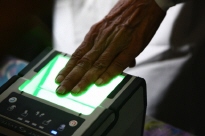
Typical street scene in Santa Ana, El Salvador. (Photo: iStock)
IMF Survey: India’s Growth Slowdown Calls for Reinvigorated Reforms
April 17, 2012
- Real GDP growth expected to slow to around 7 percent from above 8 percent
- Private investment key to realizing Indian potential
- Structural reforms are critical to boost growth, say IMF economists
Growth in India is expected to be robust this year and the next, but the recent slowdown in the country suggests policymakers need to reinvigorate structural reforms, say IMF economists.

Indian man scans his fingerprints as part of India’s new identification system, which could help target social spending (photo: Harish Tyagi/epa/Corbis)
ECONOMIC HEALTH
In their annual assessment of the Indian economy—known as the Article IV consultation—IMF economists say the South Asian country is confronting a slowdown in investment, which threatens its aim of achieving inclusive growth, or growth which benefits the poor.
The IMF expects real GDP to grow 6¾ percent in 2011/12, rising to 7 percent in 2012/13.
“While this is still a very respectable achievement, India has an even greater potential to raise the economic well-being of its population, including that of the poor,” said the IMF’s mission chief for India, Masahiko Takeda.
Toward higher, sustainable, inclusive growth
In its report, the IMF analyzed the causes of the recent growth and investment slowdown, and concluded that while cyclical factors, such as the rise in global uncertainty, high and volatile inflation, and monetary policy tightening, have had an impact, structural shortcomings have also been an important contributor.
These include infrastructure bottlenecks (power supply, road and rail transportation) and the relatively high costs of doing business.
“Private investment is critical to create jobs and reduce India’s poverty, so reducing impediments to its revival is essential,” said Takeda.
The report noted that India’s inflation remains elevated, which constrains the central bank’s ability to ease monetary policy. India’s fiscal deficit and public debt are also relatively high, so it lacks the means for a fiscal boost to revive growth. Consequently policymakers need to rely on structural reforms to go back to a higher growth path, say IMF economists.
Structural reform agenda
They suggest a wide range of reforms including simplifying permitting procedures, making contracts more enforceable, and facilitating land acquisition and making it more predictable.
The economists stressed the need to speed up reforms in the power sector, particularly through better allocation of domestic coal, by bringing state electricity boards’ finances onto a sustainable footing, and reforming coal pricing and electricity tariffs.
“Reforms of the financial sector, labor market, agriculture, and human capital development through education and training also contribute to India’s growth potential” notes the report.
Tackling inflation
The IMF report also recommends that monetary policy remains the same for the time being to meet the authorities’ inflation objectives and lower inflation expectations.
India’s inflation had been hovering close to 10 percent for several years, but since the end of last year, there has been a deceleration although it is not yet clear whether underlying inflation is weakening.
Despite slowing growth, the central bank should remain cautious and avoid premature easing of monetary policy, until the inflation rate’s downward trend is confirmed, say IMF economists. The government’s determination to continue fiscal consolidation is also helpful, as it creates room for monetary easing down the road, they add.
The role of fiscal policy
Fiscal policy could also play a role in achieving inclusive growth, say the IMF economists. India’s enormous fiscal needs for poverty reduction have to be met within a very tight budget. Efficient public spending is imperative to achieve this goal.
The economists suggest that the current subsidies on fuel and fertilizer could be streamlined by introducing a mechanism that targets the poor who are in need of government support.
The Unique Identification (UID) system, which biometrically identifies individual citizens, and is currently being rolled out, could potentially increase the efficiency of its social programs by identifying those in greatest need.
In his recent 2012/13 budget speech, the Indian Finance Minister, Pranab Mukherjee, announced that the government’s efforts will be directed toward better targeting and leakage proof delivery of subsidies, including through a pilot use of the UID system.
The Minister’s commitment to reduce the total amount of subsidies (relative to GDP) and increase capital spending was welcomed by the IMF economists. They say that these and other reforms would bring tangible payoffs in the form of revived growth, with ensuing benefits extending to the poor.
<


